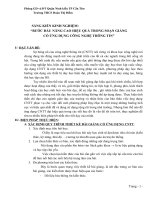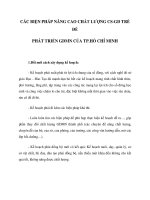Tài liệu mjang máy tính nâng cao stream control transmission protocol
Bạn đang xem bản rút gọn của tài liệu. Xem và tải ngay bản đầy đủ của tài liệu tại đây (4.5 MB, 65 trang )
Chapter 13
Stream Control
Transmission Protocol
Objectives
Upon completion you will be able to:
• Be able to name and understand the services offered by SCTP
• Understand SCTP’s flow and error control and congestion control
• Be familiar with the fields in a SCTP segment
• Understand the phases in an SCTP association
• Understand the SCTP state transition diagram
TCP/IP Protocol Suite
CuuDuongThanCong.com
/>
1
Figure 13.1 TCP/IP protocol suite
TCP/IP Protocol Suite
CuuDuongThanCong.com
/>
2
Note:
SCTP is a message-oriented, reliable
protocol that combines the
good features of UDP and TCP.
TCP/IP Protocol Suite
CuuDuongThanCong.com
/>
3
13.1 SCTP SERVICES
We explain the services offered by SCTP to the application layer
processes.
The topics discussed in this section include:
Process-to-Process Communication
Multiple Streams
Multihoming
Full-Duplex Communication
Connection-Oriented Service
Reliable Service
TCP/IP Protocol Suite
CuuDuongThanCong.com
/>
4
Table 13.1 Some SCTP applications
TCP/IP Protocol Suite
CuuDuongThanCong.com
/>
5
Figure 13.2 Multiple-stream concept
TCP/IP Protocol Suite
CuuDuongThanCong.com
/>
6
Note:
An association in SCTP can involve
multiple streams.
TCP/IP Protocol Suite
CuuDuongThanCong.com
/>
7
Figure 13.3 Multihoming concept
TCP/IP Protocol Suite
CuuDuongThanCong.com
/>
8
Note:
SCTP association allows multiple IP
addresses for each end.
TCP/IP Protocol Suite
CuuDuongThanCong.com
/>
9
13.2 SCTP FEATURES
We discuss the general features of SCTP and then compare them with
those of TCP.
The topics discussed in this section include:
Transmission Sequence Number (TSN)
Stream Identifier (SI)
Stream Sequence Number (SSN)
Packets
Acknowledgment Number
Flow Control
Error Control
Congestion Control
TCP/IP Protocol Suite
CuuDuongThanCong.com
/>
10
Note:
In SCTP, a data chunk is numbered
using a TSN.
TCP/IP Protocol Suite
CuuDuongThanCong.com
/>
11
Note:
To distinguish between different
streams, SCTP uses a SI.
TCP/IP Protocol Suite
CuuDuongThanCong.com
/>
12
Note:
To distinguish between different data
chunks belonging to the same stream,
SCTP uses SSNs.
TCP/IP Protocol Suite
CuuDuongThanCong.com
/>
13
Figure 13.4 Comparison between a TCP segment and an SCTP packet
TCP/IP Protocol Suite
CuuDuongThanCong.com
/>
14
Note:
TCP has segments;
SCTP has packets.
TCP/IP Protocol Suite
CuuDuongThanCong.com
/>
15
Note:
In SCTP, control information and data
information are carried in separate
chunks.
TCP/IP Protocol Suite
CuuDuongThanCong.com
/>
16
Figure 13.5 Packet, data chunks, and streams
TCP/IP Protocol Suite
CuuDuongThanCong.com
/>
17
Note:
Data chunks are identified by three
identifiers: TSN, SI, and SSN.
TSN is a cumulative number
identifying the association; SI defines
the stream; SSN defines the chunk in
a stream.
TCP/IP Protocol Suite
CuuDuongThanCong.com
/>
18
Note:
In SCTP, acknowledgment numbers
are used to acknowledge only data
chunks; control chunks are
acknowledged by other control chunks
if necessary.
TCP/IP Protocol Suite
CuuDuongThanCong.com
/>
19
13.3 PACKET FORMAT
We show the format of a packet and different types of chunks. An SCTP
packet has a mandatory general header and a set of blocks called
chunks. There are two types of chunks: control chunks and data chunks.
The topics discussed in this section include:
General Header
Chunks
TCP/IP Protocol Suite
CuuDuongThanCong.com
/>
20
Figure 13.6 SCTP packet format
TCP/IP Protocol Suite
CuuDuongThanCong.com
/>
21
Note:
In an SCTP packet, control chunks
come before data chunks.
TCP/IP Protocol Suite
CuuDuongThanCong.com
/>
22
Figure 13.7 General header
TCP/IP Protocol Suite
CuuDuongThanCong.com
/>
23
Figure 13.8 Common layout of a chunk
TCP/IP Protocol Suite
CuuDuongThanCong.com
/>
24
Note:
Chunks need to terminate on a 32-bit
(4 byte) boundary.
TCP/IP Protocol Suite
CuuDuongThanCong.com
/>
25









